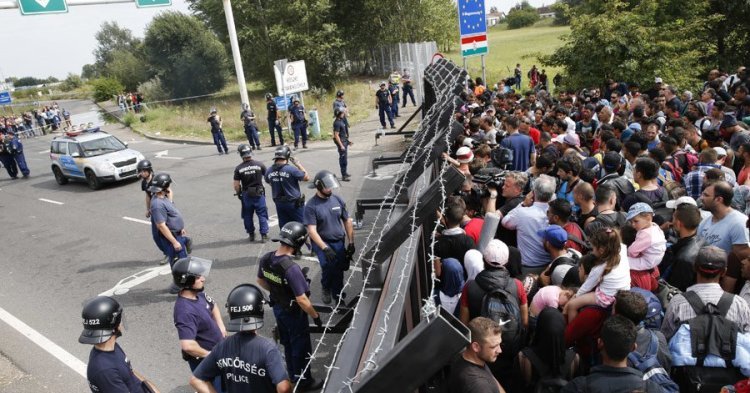The Schengen area is a unique construction in the world in terms of border controls and free movement of persons between the different Member States. This zone, which became the Area of Freedom, Security and Justice in 1999, operates on the basis of the abolition of controls at internal borders, therefore involving a postponement of controls at its external borders.
This European construction has been affected for several years by various political and geopolitical crisis that compromised the very existence of this free area. Before the Arab Springs in 2011, dictatorial regimes in North Africa had served as external border guards for the Union, substituting a joint action from the European States. Their collapse caused deep concerns around migration – especially for Italy, that has been the gate to Europe via Lampedusa for a substantial number of migrants. This major crisis revealed the weaknesses of the European construction and the growing needs of the Schengen zone.
Both structural problems of integration within the free area and difficulties in establishing effective border control procedures were compounded by the influx of populations from the Middle East, frequently escaping civil war as well as the terror of organizations like ISIS in Syria. Those who reach Europe are entitled to claim asylum under the provisions of the 1951 Refugee Convention.
The refugee crisis, as it has been called, reflects the deep lack of ability of the European authorities to welcome these individuals with dignity and with respect for fundamental rights. The problem also stems from a clear refusal to operate according to the principles of international protection, creating a very delicate situation.
The successive migration flow has led to a number of measures, in particular, a series of unilateral and unprecedented re-establishment of border controls by certain Member States, that have substantially weakened the Schengen area. Many politicians took advantage of the tense political climate to push forward processes aimed at obtaining the disappearance of one of the greatest European achievements. Yet, all of the errors made in the crisis management are only and solely due to the Member States, these same who are criticizing Schengen and the EU for the crisis.
Indeed, as can be seen in Article 3 of the Treaty on the Functioning of the European Union, Member States have insisted on maintaining absolute control over security matters – which is an absurd policy within a free, common space. The lack of harmonization in such matters has affected the development of effective cooperation schemes in the fields of intelligence and security, which has consequently undermined progress in implementing efficient mechanisms of crisis management.
I. The mismanagement of the situation
The refugee crisis, which had been announced long before its occurrence by agencies such as Frontex and the United Nations, has been manifestly mismanaged from both single Member States and the European Union.
One of the most controversial measures came about in November 2015. After the crisis triggered and European governments were caught unprepared to deal with it, despite having prior knowledge regarding it, the European Union signed an agreement with Turkey. Such a deal was conceived to halt the flux coming through the Aegean sea route, establishing a bilateral cooperation mechanism that ultimately resulted in the creation of hotpsots (registration and identification center for migrants) within the Turkish territory.
The original aim was to accommodate these persons during the time that was required to process their asylum application, but the structures soon became centers of detention in deliberate violation of fundamental rights and international law as the Office of the United Nations High Commissioner for Refugees (UNHCR) has denounced.
The 1951 Geneva Convention relating to the Status of Refugees, for example, lays down in Articles 32 and 33 a prohibition against the expulsion of asylum seekers from the frontiers «of the territories where his life or freedom would be threatened». In addition, the European Convention of Human Rights prohibits inhuman and degrading treatment, as well as the deprivation of personal liberty of migrants.
II. A dangerous and irresponsible political discourse
It could be argued that there is a deeper, internal issue around the migration crisis. The way in which domestic discourses have read and interpreted the phenomenon of migration have resulted in anti-migration positions and in a unilateral approach within the Community. The exacerbation of national sovereignties has resulted in the absence of a coherent European answer to what can easily be read as a continental question. The political narratives have created this migratory crisis from scratch.
One of the central issues is the application by States, again, of a double discourse varying according to whether they are addressing their European partners or the public opinion. These States benefit from a lack of transparency in the meetings of the European Council. Indeed, this practice of blaming the European Union is an essentially political issue that can be understood by taking into account the desire to give the illusion of the States’ refusal to abandon their sovereignty at the national level. The President Jean-Claude Juncker made a proposal about this lack of transparency at the Council as he is not willing to accept this type of behavior anymore.
The refusal of this loss of sovereignty is, as I mentioned earlier, was also reflected in the difficulty of building a common area of freedom. The Schengen area implies the disappearance of internal borders, yet the migratory crisis and terrorism have given grounds to certain States to re-establish these borders. This is permitted when public order or internal security requires by the European legislation under Article 23 of the Schengen Border Code.
However, the re-emergence of internal borders is on the rise: on January 25th, 2017, the European Commission expressed its hope to see the area getting back to its integrity in May 2017 the latest. But States do not seem to agree to such a plan. And then, in May the European commissioner on migration, Dimitris Avramopoulos, gave extra time to the States allowing border controls until this November, as the last postponing of the derogation. With no surprise, the European Commission gave another extension a few days ago in violation of the very spirit of Schengen. When will this end?
This predictable national withdrawal was reflected in absurd propositions such as the Dutch proposal for the creation of a ’mini-Schengen’ to exclude States unable to manage the migratory flows, or the construction of walls within Europe itself. It is a real political paranoia that has seized some heads of state like Viktor Orban, who has already started the construction of a 4-meters-high fence that will extend on the border with Serbia for 175 kilometers – or another one between Croatia and Hungary.
However, these violations of the very principle of the area of freedom, security and justice do not seem to be truly condemned by the Union – and neither by other Member States, probably on the grounds of hidden approval and interest.
III. A prompt treatment needed for the European Union survival
Today, the successful management of the crisis is a prerequisite for the European Union’s realisation as a whole. In the battle for sovereignty and control, the major difficulty consists in rediscovering an application of the principle of mutual trust between Member States and in allowing such principle to be put at the core of the Schengen project.
Indeed, current difficulties are questioning the founding principle of free movement of persons – and, more broadly, the Schengen agreements. The failures that we have are a deliberate threat to the Union and to the European project. The disintegration of the area of freedom would be the destruction of the core ideals and would have major economic consequences for the continent as well.
The President of the Commission Juncker describes the state of the free space as « partially comatose », calling for strong measures to be taken in order to safeguard and significantly strengthen its functioning. The solution would be to further integrate the area of freedom, security and justice in order to allow the implementation of all the measures that will strengthen external borders, which would then have a function of « filter », according to the will of the Council. However, this would require a strong political determination and a significant transfer of sovereignty.
José Manuel Barroso, by indicating that « the re-establishment of borders is one possibility among others », has also participated to this discourse. However, it is not the right time for the Schengen agreements to be revised, at least not until the principle of free movement of goods and persons within internal borders is conceived as fundamental.
The area of asylum and immigration policies, despite the provisions of the Lisbon Treaty, is one in which intergovernmental logic seems to resist the advent of the integrative approach for a number of reasons.
First, Member States remain reluctant to concede competence in sensitive areas affecting public opinion to the EU authorities, dismissing the legal scope of the treaties which stress the importance of a spirit of integration in these matters. Some States are increasingly tempted by a national withdrawal, as MEP’s Joseph Daul (EPP) denounced: « To the wave of immigrants who reach our coasts in precarious conditions, who die at sea, our countries react too often by dividing, quarreling, border closures and even calling into question an instrument of freedom of movement as essential as Schengen ».
The closure of internal borders would be the death of the European Union. This would also be a bit contradictory while the internal market presupposes an increase in the mobility of Europeans.
However, the closure of external borders, although politically necessary, would affect European citizens first and foremost: according to statistics established in 2010, some 12.6 million people cross European borders each week, 73.5% of whom are citizens of the European Union and persons enjoying the right to free movement within the Union, 15.2% are nationals of other countries who do not require a visa and 11.3% need a visa. It is time to end the fiction and fake nightmare of an invasion of the European space by foreigners: the European Union has 19.5 million immigrants, which only represent 3.9% of the total population.
If by any chance the arguments based on the requirement of respect for the rights of individuals who seek refuge, employment and hope in Europe are not heard, it is necessary to emphasize the necessity for the European economy which greatly needs the living forces of immigrants as evidenced by the German economic growth boosted in 2016 to 1.9% of GDP thanks to these migrants, between 0.3 and 0.5% more than estimated.
Let’s welcome the refugees. And more, let’s go back to the Schengen spirit and the construction of an area of freedom, security and Justice.




Follow the comments: |
|
